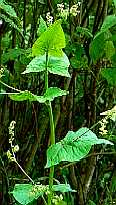View crop
View crop Data sheet EcoPortFagopyrum tataricum
 |
|
| Notes |
|---|
| DESCRIPTION: It is an erect herbaceous plant reaching 60-90 cm in height. It has a single main stem with branches, a short tap root and green-white flowers densely clustered in racemes at ends of short petioles from leaf axil. The seeds of buckwheat are actually entire fruits called achenes. USE: It is marketed as flour and used in food or as feed for livestock. Buckwheat has the same nutritive efficiency as proteins of animal origin. It may be fed whole to poultry. Buckwheat middling make satisfactory protein supplement for cattle and hogs. It is a good source of honey which is dark in colour and has a strong flavour. Buckwheat thrives on land of low productivity and produces a green manure crop in a short period of time. When ploughed under, the plant material decays rapidly making N and mineral constituents available for the succeeding crop. GROWING PERIOD Annual, growing 70-85 days. COMMON NAMES Sibiriskt bovete (Sweden), Vill bokkveite (Norway), Tatarisk Boghvede (Denmark), Rikkatatar (Finland), Green Buckwheat, Tartary buckwheat, Indian wheat, Siberian buckwheat, Tartarian buckwheat (England), Falsche Buchweizen (Germany). FURTHER INF: Scientific synonym: Polygonum tataricum L. Tartary buckwheat is considered more hardy than common buckwheat. It is native of parts of Asia. It can become a weed of pastures or Fagopyrum esculentum fields. | Sources |
| SOURCES (Fagopyrum tataricum) Dube P 1982 pp 38 Roecklein J 1987 pp 43 [USE] Duke J 1975 pp 16 [PH, RAIN, TEMP] Kernick M 1961 pp 187 [KTMP, TEXT, TEMP, FER, PH, DRA, USE] |